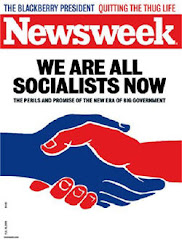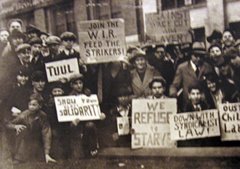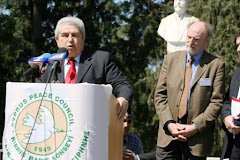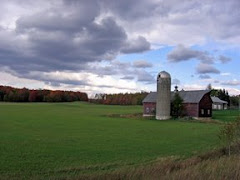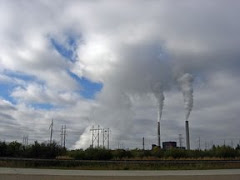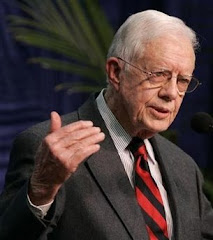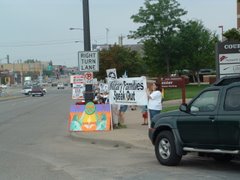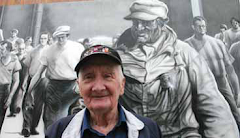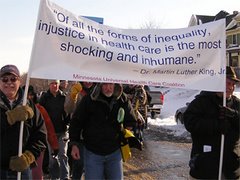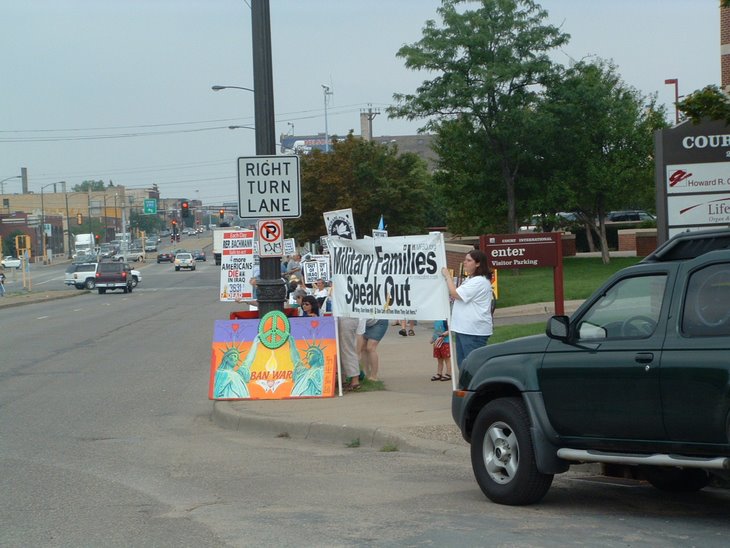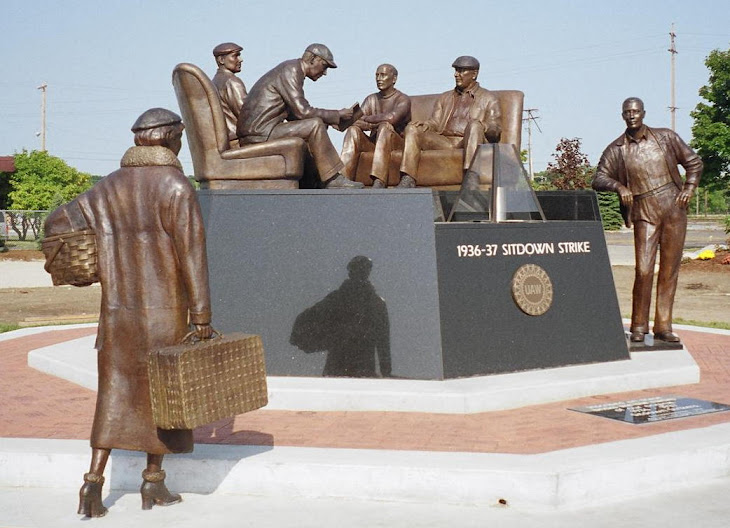 (Photo: Shira Golding Evergreen / Flickr)With
Americans' interest in socialism rising, we need to seriously consider
alternative designs to the current system, argues Alperovitz, in this
practical critique of some known models.
(Photo: Shira Golding Evergreen / Flickr)With
Americans' interest in socialism rising, we need to seriously consider
alternative designs to the current system, argues Alperovitz, in this
practical critique of some known models.
Little
noticed by most Americans, Merriam Webster, one of the world's most
important dictionaries, announced a few months ago that the two most
looked-up words in 2012 were "socialism" and "capitalism."
Traffic
for the pair on the company's website roughly doubled from the year
before. The choice was a "kind of no-brainer," observed editor at large,
Peter Sokolowski. "They're words that sort of encapsulate the
zeitgeist."
Leading
polling organizations have found converging results among younger
Americans. Two recent Rasmussen surveys, for instance, discovered that
Americans younger than 30 are almost equally divided as to whether
capitalism or socialism is preferable. Another Pew survey found those
aged 18 to 29 have a more favorable reaction to the term "socialism" by a
margin of 49 to 43 percent.
Note carefully: These are the people who will inevitably be creating the next American politics and the next American system.
As
economic failure continues to create massive social and economic pain
and a stalemated Washington dickers, search for some alternative to the
current "system" is likely to continue to grow. It is clearly time to
get serious about a different vision for the future. Critically, we need
to be far more sophisticated about what a meaningful "systemic design"
that might undergird a new direction (whether called "socialism" or
whatever) would entail.
Classically,
the central idea undergirding various forms of "socialism" (and there
have been many, many forms, some of which use the terminology, some not)
is democratic ownership of "the means of production," or "capital," or
more simply, "productive wealth." Quite apart from questions of
exploitation, systemic dynamics (and "contradictions"), the core idea is
simple and straightforward: Those who own wealth - and the corporations
that operate it - have far more power to control any system than those
who don't.
In
a nation in which a mere 400 people own more wealth than the bottom 180
million together, the point should be obvious. What is new in our time
in history is that the traditional compromise position - namely
progressive, or social democratic or liberal politics - has lost is
capacity to offset such power even in the modest (compared, for
instance, to many European states) ways the American welfare state once
represented. Indeed, the emerging direction is to cut back previous
gains in many areas - not to sustain or enlarge them. Even Social
Security is now on the table for cuts.
Perhaps
the most important reason for the decline of the traditional reform
option is the decline of labor: Union membership has steadily decreased
from roughly 35 percent of the labor force in 1954, to 11.3 percent now -
a mere 6.6 percent in the private sector.
Along
with this decay, and give or take an exception here and there, major
trends in income and wealth, in civil liberties, in ecological
devastation (and the release of climate-changing gases), in poverty and
many other important indicators have been "going South" for several
decades.
It
is, accordingly, not surprising that dictionary look-ups and polls show
interest in "something else." If, as is likely, the trends continue,
that interest is also likely to increase. But what, specifically, might
that "something else" entail? And is there any reason to hope - even as
interest in the word "socialism" grows in the abstract - that we might
move from where we are to "some other system" that might nurture
equality, liberty, ecological sustainability, even global peace, more
than the current decaying one we now have?
New Models of Socialist Structures
The
classic model of socialism involved state (national) ownership of most
large-scale capital and industry. But it is now clear to most observers
that the concentration of such ownership in the state also commonly
brings with it a concentration of political power as well; hence, the
model can be detrimental to democracy as well as liberty (to say
nothing, in real world experience, of the environment).
Alternative
places to locate ownership have been suggested by different traditions:
in cooperatives, in worker-owned firms, in municipalities, in regions,
even in neighborhoods. Some of the advantages and challenges involved in
the various forms are also well-known:
Starting at the ground level, there appear in virtually all studies to be very good reasons - for small and medium-size firms -
to arrange ownership through cooperatives and worker-owned and
self-managed enterprises. This is where direct democratic participation
is (or can be) strongest, where a new culture can be developed and where
a very different vision of work can evolve. Very solid proposals have
been offered in such books as John Restakis' Humanizing the Economy: Co-operatives in the Age of Capital and Richard Wolff's Democracy at Work: A Cure for Capitalism (on what he calls "worker self-directed enterprises").
On
the other hand, for larger, significant-scale enterprises,
worker-ownership may not solve some critical problems. When worker-owned
large firms operate in a market-based system (as proposed by some
progressive analysts), groups of workers in such firms may develop
narrow interests that are not necessarily the same as those of the
society as a whole. (It may be in their interests, for instance, to
pollute the community's air and water rather than pay cleanup costs -
especially when the firm faces stiff competition from other private or
worker-owned companies.) Studies of worker-owned plywood companies in
the Northwest found that all too easily workers developed narrow
"worker-capitalist" attitudes (and conservative political views) as they
competed in the marketplace. Nor does such ownership solve problems of
inequality: Workers who "own" the garbage companies are clearly on a
different footing, for instance, than specific groups of workers lucky
enough to "own" the oil industry.
Often
here - and in several other variants of socialist ideas - it is hoped
that a new culture (or ideology) or progressive forms of taxation,
regulation and other policies can offset the underlying tendencies of
the models. However, there is reason to be skeptical of "after-the-fact"
remedies that hope to counter the inherent dynamics of any model, since
political power and interest group influence often follow from
ownership irrespective of good intentions and the hope that progressive
political ideals, or ideology, will save the day. If the attitudes
nurtured by the plywood co-ops turn out to be the norm, then new
worker-owned companies would likelynot generate strong support for regulations and taxation that help society at large but restrict or tax their own firm.
Let me stress that we simply do not know whether this might or might not be the case. It is, however, a mistake to assume either
that socially responsible regulations can be "pasted on" to any
institutional substructure (especially if they create costs to that
substructure), or that institutions will automatically generate a
sufficiently powerful cooperative culture and institutional power
dynamic in favor of regulations and taxation even if it adds costs to
their own institution and is detrimental to the material interests of
those involved.
To
get around some of these problems, some theorists have proposed
democratically managed enterprises that are nonetheless owned by the
broader society through one or another structural form. Although workers
in the "self-managed" firm could gain from greater efficiency and
initiative, major profits would go to the society as a whole. Still,
note that in such cases, too, the incentive structure of the competitive
market tends to create incentives to reduce costs - for instance, by
externalizing environmentally destructive wastes. Also, when there are
economies of scale, market-based systems generate very powerful
pressures to adopt new technologies and prioritize growth (or lose out
to other firms that also are under pressure to grow and adopt new
technologies) - and this dynamic, too, runs counter to the needs of an
ecologically sustainable future.) John Bellamy Foster's The Ecological Revolution, among other efforts, gives depth to the ecological foundational arguments further systemic designs must consider.
Designing for Community
We
are clearly at the exploratory stage in connection with these matters,
but the really important question is clearly whether a new model might inherently generate
outcomes that do not require "after-the-fact" policy fixes or attempted
fixes it is hoped the political system will supply. Especially since
such "fixes" come out of a larger culture, the terms of reference of
which are significantly set by the underlying economic institutions, and
if these develop competitive and growth-oriented attitudes, the
outcomes are likely to be different from those hoped for by progressive
proponents. Lest we jump to any quick conclusions, it is again important
to be clear that no one has as yet come up with a serious "model" that
might both achieve efficiencies and self-directed management - and also
work to create an equitable, ecologically sustainable larger culture and
system. All have flaws.
Some
of the problems and also some of the design features of alternatives,
however, begin to suggest some possible directions for longer-term
development:
For instance, a third model that has traditionally had some resonance is to locate primary ownership of significant scale capital
in "communities" rather than either the state or specific groups of
workers - i.e. in geographic communities and in political structures
that are inclusive of all the people in the community. (By definition
geographic communities inherently include not only the workers who at
any moment in time may only include half the population, but also
stay-at-home, child-rearing males or females, the elderly, the infirm,
children and young people in school - in short the entire community.)
Community
models also inherently "internalize externalities" - meaning that
unlike private enterprise or even worker-owned companies that may have a
financial interest in lowering costs by not cleaning up environmentally
destructive practices, community-owned firms are in a different
position: If the community chooses to continue such practices, it is
polluting itself, a choice it can then examine from a comprehensive
perspective - and in a framework that does not inherently pose the
interests of the firm against community-wide interests.
Variations
on this model include the "municipal socialism" that played so
important a role in early 20th century American socialist politics - and
is still evident in more than 2,000 municipally owned utilities, a good
deal of new municipal land development and many other projects. "Social
ecologist" Murray Bookchin gave primary emphasis to a municipal version
of the community model in works likeRemaking Society: Pathways to a Green Future,
and Marxist geographer David Harvey has begun to explore this option as
well. (As Harvey emphasizes, any "model" would likely also have to
build up higher level supporting structures and could not function
successfully were it left to simply float in the free market without
some larger supporting system.)
Current
suggestive practical developments in this direction include a complex
or "mixed" model in Cleveland that involves worker co-ops that are
linked together and subordinated to a community-wide, nonprofit
structure - and supported by something of a quasi-planning system
(directed procurement from hospitals and universities that depend in
significant part on public financial support). An earlier model
involving joint community and worker ownership was developed by
steelworkers in Youngstown, Ohio, in the late 1970s.
The
Jewish theologian Martin Buber also offered a community-oriented
variation based on cooperative ownership of capital in one geographic
community. He saw this "full cooperative" (and confederations of such
communities) as an answer the problems both of corporate capitalism and
of state socialism. Buber's primary practical experimental demonstration
was the Israeli cooperative commune (kibbutz), but the principle might
well be applied in other forms. Karl Marx's discussion of the Paris
Commune (and of the Russian village commune or mir) is also suggestive of possibilities in this direction.
In
the various community models there is also every reason to expect that
specific communities will develop "interests" that may or may not be the
same as those of the society as a whole. (Again think of communities
located on top of important natural resources versus others not so
favored.) The formula based on community ownership, however, may have a
potential advantage that might under certain circumstances - and with
clear intent - help at least partly offset the tendency for any
structural form to produce narrow interest-group ideas and power. This
is the simple fact that a fully inclusive structure that nurtures ideals
of "community" - as opposed to ideas of individual ownership, on the
one hand, or worker-group ownership of specific firms, on the other -
may offer greater possibilities for building a common culture of
community, one in which norms of equal treatment and common interest are
inherently generated by the structural design itself (at least within
communities and possibly beyond.)
To
the extent this is so, or could be nurtured, a systemic design based on
communities (or joint worker-community ownership) might both allow for
decentralization and also for the generation of common values. A subset
of issues also involves smaller scale geographic community ownership, in
the form of neighborhoods. And such a model might also include a mix of
smaller scale worker-owned and cooperative forms, and even (larger
scale) state and nationally owned public enterprise as well - a
structural form that is now far more common and efficient in many
countries around the world than is widely understood.
Questions of Scale
Social
ownership by neighborhoods, municipalities, states, and, of course,
nations (all with or without some formula of "joint" worker ownership)
are not the only models based on the fact that geography is commonly
inherently inclusive of all parties - and therefore potentially capable
of helping nurture inclusive norms and inclusive cultures. A final
formula (for the moment) for significant scale and ultimately large
industry is also based on geography, but at a different level still.
This attempts to resolve some of these problems (and that of genuine
democratic participation) by defining the key unit as a region, a
formula urged by the radical historian, the late William Appleman
Williams, as especially appropriate to a very large nation like the
United States. It is not often realized how very different in scale the
United States is from most European nations: Germany, for instance, can
be tucked into a geographic area the size of Montana. Nor have many
faced the fact that our current 315 million-person population is likely
to reach 500 million over coming decades (and possibly a billion by the
end of the century, if the US Census Bureau's high estimate were to be
realized.) During the Depression, various regional ownership models like
the Tennessee Valley Authority were proposed, some of which were far
more participatory and democratic in their design than the model that is
currently in place. Legislation to create seven large-scale,
publicly-owned regional efforts was, in fact, supported by the Roosevelt
Administration at certain points in time.
Many
other variations, of course, also have been proposed. The Parecon
model, for instance, would attempt to replace a system of market
exchanges with a system in which citizens would iteratively rank their
preferences for consumer goods along with proposed amounts of proffered
labor time. Proposals, like that of David Schweickart in
After Capitalism,
pick up on forms of worker self management, but also emphasize national
ownership of the underlying capital. Seth Ackerman, in a
recent essay for
Jacobin, urges a worker-controlled model, but stresses the need for
independent sources of publicly controlled investment capital. Other
thinkers, like Michael Leobowitz in his book,
The Socialist Alternative: Real Human Development,
have taken inspiration from Latin America's leftward movement, and
especially from Venezuela, to articulate a participatory vision of
socialism rooted in democratic and cooperative practices. Joel Kovel in
The Enemy of Nature argues
that the impending ecological crisis necessitates a fundamental change
away from the private ownership of earth's resources.
And,
of course, the question of planning versus markets needs to be put on
the list of design challenges. Planning has its own long list of
challenges - including, critically, who controls the planners and
whether participatory forms of planning may be developed drawing on
smaller scale emerging experience and also on a much more focused
understanding of what needs to be planned and what ought to be
independent of public direction. (Also how the market can be used to
keep a planning system in check.)
As
noted, there is also the question of enterprise scale - a consideration
that suggests possible mixes of different forms of social ownership:
where to locate the ownership and control of very large scale firms is
one thing; very small another; and intermediate still another. Most
"socialist" models these days also allow for an independent sector that
includes small independent capitalist firms, especially in the
innovative high-tech sector.
Related
to all this is the question of function: The development and management
of land, for instance, is commonly best done through a geographic
institution - i.e. a neighborhood or municipal land trust. Public forms
of banking and finance tend also to be best anchored in (though operated
independently of) cities, states and nations. Though medical practices
must be local, social or socialized health systems tend
to work best in areas that include large populations - i.e. states or
nations. In some cases, quite apart from efficiency considerations,
ecological considerations make regions especially appropriate. (One of
the rationales, originally, for the Tennessee Valley Administration had
to do with managing a very challenging river system.)
On the Ground Now
Finally,
there is much to learn from models abroad - particularly Mondragon, on
the one hand, and the worker-cooperative and other networks in the
Emilia Romagna region of Italy, on the other. The first, Mondragon, has
demonstrated how an integrated system of more than 100 cooperatives can
function effectively (and in areas of high technical requirement) - and
at the same time maintain an extremely egalitarian and participatory
culture of institution control. The Italian cooperatives have
demonstrated important ways to achieve "networked" production among
large numbers of small units - and further, to use the regional
government in support of the overall effort. Though the experience of
both is extraordinary, simple extrapolations may or may not be possible:
Both models, it is also important to note, developed out of historical
contexts that helped create intense cultural and political solidarity -
contexts also of extraordinary repression by fascist regimes, Franco in
Spain, Mussolini in Italy. Finally, although the Emilia Romagna
cooperatives are effective in their use of state policy, both models are
best understood as institutional "elements" that may contribute to a
potential national solution. Neither claims to, or attempts to, develop a
coherent overall "systemic" design for a nation.
These
various abstract considerations come down to earth when one realizes
that there is far more going on, practically, on the ground related to
the ownership forms than most people realize - a great deal that is not
covered by the increasingly hobbled and financially constrained press.
For a start, around 130 million Americans - 40 percent of the population
- are members of one or another form of cooperative, a traditional
collective ownership form that now includes large numbers of credit
unions, agricultural co-ops dating back to the 1930s, electrical co-ops
prevalent in many rural areas, insurance co-ops, food co-ops, retail
co-ops (such as the outdoor recreational company REI and the hardware
purchasing cooperative ACE), health-care co-ops, artist co-ops and many,
many more.
There
are also many, many worker-owned companies structured in ways different
from traditional co-ops - indeed, around 11,000 of them, involving 10.3
million people, in virtually every sector, some very large and
sophisticated. Technically, these companies are structured as ESOPs
(Employee Stock Ownership Plans) - and in fact 3 million more
individuals are involved in worker-owned companies of this kind than are
members of unions in the private sector. (Though there have been a
variety of problems with this form, there has also been evolution with
greater worker control and also experiments with unionization that in
the future might suggest important additional possibilities.) Finally
and critically, the United Steelworkers have put forward
a new direction in union-worker co-ops.
There
are also thousands of "social enterprises" that use democratized
ownership to make money and use both the money and the enterprise itself
to achieve a broader social purpose. By far the most common social
enterprise is the traditional Community Development Corporation, or CDC.
Nearly 5,000 have long been in operation in almost every US city of
significant size. For the most part, CDCs have served as low-income
housing developers and incubators for small businesses. Early on in the
50-year history of the movement, however, a different, larger vision was
in play - one that is still present in some of the more advanced CDC
efforts and one that suggests additional possibilities for the future.
Still
another form of democratized ownership involves growing numbers of
"land trusts" - essentially neighborhood or municipal corporations that
own housing and other property in ways that prevent gentrification and
turn development profits into support of low- and moderate-income
housing. One of the best known is the Champlain Housing Trust in
Burlington, Vermont, which traces its modest beginnings to the early
1980s and now provides accommodation for more than 2,000 households.
Hundreds of such collective ownership efforts now exist, and new land
trusts are now being established on an expanding, ongoing basis in
diverse contexts and cities all over the country.
Since
2010, twenty states have also considered legislation to establish
public banks like that of North Dakota, which has operated with strong
public support for more than nine decades. Approximately 20 states have
considered legislation to establish single-payer health-care plans. Nor
should we forget that the United States government de facto nationalized
General Motors and AIG, one of the largest insurance companies in the
world, during the recent crisis. It started selling them back once the
profits began to roll, but in future crises, different outcomes might be
ultimately achieved if practical experiments at the local and state
level begin to create experiences that might be generalized to national
models when the time is right - especially if the current system
continues to decay and deteriorate. (Many of the national models that
became the core programs of the New Deal were incubated in the state and
local "laboratories of democracy" in the decades prior to the time
national political possibilities opened up).
At
this stage of development, there is every reason to experiment with
many forms - a "community-sustaining" direction that I have suggested
might be called a "Pluralist Commonwealth" to emphasize the plurality of
common or democratized wealth-holding efforts.
Getting Serious
I
obviously do not hope in this brief sketch to try to offer a fully
developed alternative. My goal is much simpler: First, to suggest that
the questions classically posed by the word "socialism" that is now
coming back into public use need to be discussed and debated by a much
broader group than has traditionally been concerned with these issues;
and second, to suggest further that if one looks closely there is
evidence that some of the potential real world elements of a solution
may be developing in ways that might one day open the way to a very
American and very populist variant (whether called "socialist" or not).
It is time, accordingly, to discuss the deeper design issues carefully
and thoughtfully and in ways that involve a much larger share of the
very large numbers of people, beyond the traditional left, who the polls
and dictionary inquiries suggest may be interested in these questions.
Even
as we learn more and more about the various forms and their positive
and negative features and tendencies, hopefully we can engage in a
far-reaching and thoughtful debate about how a new model might be
created that is both systemically sophisticated and also appropriate to
American culture and traditions - a model that nurtures democracy and a
culture of inclusiveness and ecological sanity. Many serious and
committed people on the left have been struggling with these issues and
keeping the critical questions alive for decades. Even though the way
forward, politically, is obviously daunting, difficult and uncertain, it
is time to widen the dialogue in ways that include the millions of
Americans who now seem increasingly open to the challenge.
Nor
should the pessimism of the moment undercut what needs to be done:
Anyone looking at Latin America 30 years ago might easily have been
judged foolish to think change could occur - and that debate concerning
these kinds of questions was important. Yet even during and through the
pain - and the torture and dictatorship - new beginnings somehow were
made in many areas and by many people. Our own course may be difficult,
but easy pessimism is an all-too-common escape mechanism to avoid
responsibility. It is also comforting: If one buys the judgment that
nothing can ever be done, that it is impossible, one has an excuse not
to try and also not to try to reach out to others. The fact is the
failings of the present system are themselves forcing more and more
people to explore new ideas and develop new experiments and new
political efforts.
The
important points to emphasize are three: [1] There is openness in the
public, and especially among a much, much broader group than many think,
to discussing these issues - including even the word "socialism;" [2]
It is accordingly time to get very serious about some of the challenging
substantive and theoretical issues involved; and [3] There are also
many on-the-ground experiments, and projects and developments that
suggest practical directions that are under way, but also that a new
politics (whatever it is called) might begin to build upon them if it
got serious.
 (Photo: Shira Golding Evergreen / Flickr)With
Americans' interest in socialism rising, we need to seriously consider
alternative designs to the current system, argues Alperovitz, in this
practical critique of some known models.
(Photo: Shira Golding Evergreen / Flickr)With
Americans' interest in socialism rising, we need to seriously consider
alternative designs to the current system, argues Alperovitz, in this
practical critique of some known models.


































